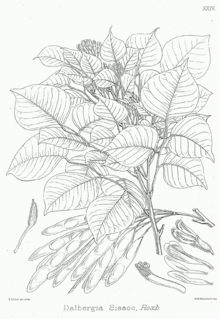Indian rosewood
| Dalbergia sissoo | |
|---|---|
 |
|
| Scientific classification | |
| Kingdom: | Plantae |
| (unranked): | Angiosperms |
| (unranked): | Eudicots |
| (unranked): | Rosids |
| Order: | Fabales |
| Family: | Fabaceae |
| Genus: | Dalbergia |
| Species: | D. sissoo |
| Binomial name | |
|
Dalbergia sissoo Roxb. |
|
| Synonyms | |
|
|
Dalbergia sissoo, known commonly as North Indian Rosewood, is a slow-growing, hardy deciduous rosewood tree native to the Indian Subcontinent and Southern Iran. D. Sissoo is a large, crooked tree with long, leathery leaves and whitish or pink flowers.
Common names for D. Sissoo are sisu, tahli or tali, and also irugudujava. Indian common names are biradi, and sisau. In Afghanistan its name is shewa, and in Persian, it is called jag. D. Sissoo is the state tree of Punjab state (India) and the provincial tree of Punjab province (Pakistan).
The wood of D. Sissoo is known as sheesham or shisham and is an important commercial timber.
D. sissoo is a medium to large deciduous tree with a light crown which reproduces by seeds and suckers. It can grow up to a maximum of 25 m (82 ft) in height and 2 to 3 m (6 ft 7 in to 9 ft 10 in) in diameter, but is usually smaller. Trunks are often crooked when grown in the open. Leaves are leathery, alternate, pinnately compound and about 15 cm (5.9 in) long. Flowers are whitish to pink, fragrant, nearly sessile, up to 1.5 cm (0.59 in) long and in dense clusters 5–10 cm (2.0–3.9 in) in length. Pods are oblong, flat, thin, strap-like 4–8 cm (1.6–3.1 in) long, 1 cm (0.39 in) wide and light brown. They contain 1–5 flat bean-shaped seeds 8–10 mm (0.31–0.39 in) long. They have a long taproot and numerous surface roots which produce suckers. Young shoots are downy and drooping; established stems with light brown to dark gray bark to 2.5 cm (0.98 in) thick, shed in narrow strips; large upper branches support a spreading crown.
D. Sissoo is native to the foothills of the Himalayas. It is primarily found growing along river banks below 900 metres (3,000 ft) elevation, but can range naturally up to 1,300 m (4,300 ft). The temperature in its native range averages 10–40 °C (50–104 °F), but varies from just below freezing to nearly 50 °C (122 °F). It can withstand average annual rainfall up to 2,000 millimetres (79 in) and droughts of 3–4 months. Soils range from pure sand and gravel to rich alluvium of river banks; shisham can grow in slightly saline soils. Seedlings are intolerant of shade.
D. Sissoo is the larval food plant of the black rajah (Charaxes solon).
Shisham is best known economic timber species of the rosewood genus sold internationally, but it is also used as fuel wood and for shade and shelter. With its tolerance of light frosts and long dry seasons, this species deserves greater consideration for tree farming, agro forestry and deciduous reforestation. After teak, it is the most important cultivated timber tree of Bihar, which is the largest producer of shisham timber in India. In Bihar, the tree is planted on roadsides, along canals and as a shade tree for tea plantations. It is also commonly planted in southern Indian cities like Bangalore as a street tree.
...
Wikipedia
